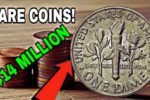Coins That Turn Pocket Change Into Millions
Every day, Americans use pennies and quarters without a second thought, but some of these coins are worth way more than their face value. Rare minting errors can turn a simple penny or quarter into a treasure worth up to $1 million or more. From mistakes in metal to misprinted designs, these errors make certain coins collector’s gold. Stories of coins like the 1943 bronze penny or the 1976 Bicentennial Quarter selling for huge sums have sparked excitement among hobbyists. Let’s uncover what makes these coins so valuable and how to spot one.
The Magic of Minting Mistakes
Coin errors happen when something goes wrong during production at the U.S. Mint. Maybe the wrong metal is used, or the design is stamped off-center. These mistakes are rare, and collectors pay big money for them. For example, a 1943 bronze penny, accidentally made with copper instead of steel during World War II, sold for $1 million because only a handful exist. Similarly, a 1976 Bicentennial Quarter with a double die error, where the design appears doubled, can fetch thousands. These errors make coins stand out, turning everyday change into a fortune.
Top Errors That Boost Coin Value
Certain errors are known for driving up a coin’s price. Here are some to look for:
- Wrong Metal: A coin struck on the wrong blank, like the 1943 bronze penny, can be worth $500,000 to $1 million.
- Double Die: The design, like letters or dates, looks doubled due to a misaligned die, valued at $500 to $15,000.
- Off-Center Strike: The design is misaligned, sometimes missing part of the image, worth $100 to $5,000.
- Missing Mint Mark: A coin missing its mint mark, like an “S” or “D,” can fetch $1,000 to $10,000.
| Error Type | Value Range |
|---|---|
| Wrong Metal | $500,000 – $1M |
| Double Die | $500 – $15,000 |
| Off-Center Strike | $100 – $5,000 |
| Missing Mint Mark | $1,000 – $10,000 |
How to Find a Million-Dollar Coin
Spotting a valuable coin starts with a close look. Check the date and mint mark—coins from San Francisco (“S”) or Denver (“D”) can be worth more than those from Philadelphia (no mark). Use a magnifying glass to spot doubling in letters or designs, or check if the coin looks off-center. For pennies, a magnet can help: steel pennies stick, but a 1943 copper penny won’t. Weighing coins is another clue—a 1943 bronze penny is 3.11 grams, while a steel one is 2.7 grams. For quarters, silver Bicentennial coins (5.75 grams) are heavier than copper-nickel ones (5.67 grams). If you think you’ve got a rare coin, take it to a professional grader like PCGS or NGC for an appraisal.
The Thrill of the Hunt
Coins like the 1943 bronze penny or Bicentennial Quarter are more than money they’re pieces of history. The 1943 penny ties to World War II, when copper was scarce, and the 1976 quarter celebrates America’s 200th birthday. Finding one of these rare coins feels like striking gold. Collectors love the chase, and stories of million-dollar coins keep the hobby alive. Next time you’re digging through change, take a moment to inspect your coins. A quick check with a magnet or magnifying glass could reveal a treasure. If you find something unusual, get it checked by a coin expert you might be holding a million-dollar story.



